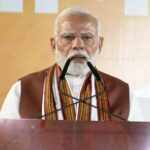New Delhi, October 13 . The ‘PM Gati Shakti National Master Plan’ (PMGS – NMP), launched by the Central Government to increase the pace of infrastructure development in the country, has completed three years. It was launched by the Modi government on October 13, 2021.
The ‘PM Gati Shakti’ scheme was launched by the Central Government for the rapid development of railways, roads, ports, waterways, airports, transport and logistics infrastructure. Its objective is to accurately plan a project and complete it at a fast pace by coordinating between government departments and ministries.
At present, there are 44 central ministries and 36 state and union territory governments on the ‘PM Gati Shakti National Master Plan’ portal. With the arrival of PM Gati Shakti, the pace of development of the country’s infrastructure has got a big boost. There are more than 1,600 data layers on this portal, which help government departments to make infrastructure projects economical. At present, more than 533 projects have been mapped in it.
So far, 213 projects worth Rs 15.48 lakh crore have been evaluated in the Network Planning Group Meeting under PM Gati Shakti. So far, 8,891 km of roads and 27,000 km of railway tracks have been planned using the PM Gati Shakti National Master Plan.
With its help, 13 GW green energy project from Leh (Ladakh) to Kaithal (Haryana) has been aligned according to the Green Energy Corridor. On the completion of three years of PM Gati Shakti, Prime Minister Narendra Modi wrote on social media, “Thanks to Gati Shakti, the country is moving forward with speed to fulfill our dream of a developed India. It will encourage progress, entrepreneurship and innovation.” Further, he wrote in another post, “PM Gati Shakti National Master Plan has emerged as a transformational initiative aimed at revolutionizing India’s infrastructure. It has significantly enhanced multimodal connectivity, leading to faster and more efficient growth across all sectors. It has boosted logistics, reduced delays and created new opportunities for many.”










